
As mentioned in my previous post on History Month 07, last Saturday, I attended a study day at the Museum of London. I had already attended a similar event last year and my expectations were high.
As is most often the case when your expectations are high, they are disappointed. Not that the event wasn't well organised or that the speakers were not of good quality but while last year's day was very much about LGBT history and was in fact a series of lectures, this year's event was perhaps more on the reflective side and less on the instructive side, with several panel discussions.
Unlike last year, where there were about one hundred attendees, this year's meeting was also very poorly attended. Only about twenty people graced the red seats of the Museum's auditorium for its very last event before being teared down and rebuilt.
After a welcoming word from Dr Darryl McIntyre, Director of public programmes for the Museum, Peter Tatchell took the stage to tell us about activism in the past 40 years or so. He mentioned the Gay Liberation Front, the demonstrations against Section 28 and his own actions with Outrage! but particularly dwelled, quite amusingly, on his first attempt at a citizen's arrest on Robert Mugabe outside a posh hotel near Victoria Station. He explained how he had to pretend he was a journalist from the gay press acting on a tip that Elton John was in the hotel with a new lover to alleviate Mugabe's security's suspicions. The attempt didn't come to much, with Tatchell and his friends being arrest by the police they had called while Mugabe was left to go free.
From the lectern, Peter Tatchell then moved to a table and was joined by Sue Sanders and Martin Dockrell who works with GMFA for a panel discussion on activism. After a few words by Martin Dockrell, the audience was invited to participate. There were questions on the role of History Month and a potential upcoming backlash against LGBT rights in the near future. The panellists seemed to agree that while we had won a major battle (on the legal side), we had by no means won the war and that people need to remain engaged, active and vigilant. According to Peter Tatchell, history does not have a linear progress and we have to expect a few steps back before moving forward again.
We were then introduced to Robert Mills, a medievalist from King's College, London. His paper, called "London's Medieval Sodomites Revisited", was a critical analysis of a 1984 article by Wayne Dynes and Warren Johansson which had been published in the Cabirion, a gay scholarly journal also known as the Gay Books Bulletin and published between 1979 and 1985 by the Gay Academic Union in New York. The article, titled "London's Medieval Sodomites" purports to find evidence of a visible and elaborate gay subculture in medieval London and conclude from that the London of 1192 was not very different from the London of 1982. This is mostly based on a passage from Richard of Devizes's Chronicon de rebus gestis Ricardi Primi (1192) which lists as a warning to the young a series of "parasites" that could apparently be met on the streets of London at the time. The list goes as follows: Minstrels, jesters, beardless pretty boys [glabriones], Moors, flatteres, little hustlers, effeminates [molles, which produced “mollies” in the 18th c.], male lovers [mascularii], dancing girls, drug pushers, harlots, spirit mediums, sorceresses, night-walkers, magicians, mimes, beggars and buffoons.
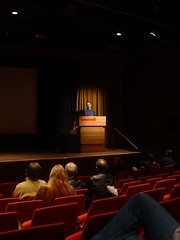 Mills theory is that the text, because of the inordinate number of classical and biblical references it is laced with, can not be read as a true historic record. Devizes' account should on the contrary be read as a satire and a challenge of contemporary Christian myths against the Jewish community and its mores; particularly the stories of ritualistic murders of Christian boys by the Jews of Winchester (where Devizes was based). The list above has strong echoes of the Bible (Corinthians 6:9-10) and Horace's Satire (1.2).
Mills theory is that the text, because of the inordinate number of classical and biblical references it is laced with, can not be read as a true historic record. Devizes' account should on the contrary be read as a satire and a challenge of contemporary Christian myths against the Jewish community and its mores; particularly the stories of ritualistic murders of Christian boys by the Jews of Winchester (where Devizes was based). The list above has strong echoes of the Bible (Corinthians 6:9-10) and Horace's Satire (1.2).
While there is, thanks to criminal records, much evidence of what was going on in Florence, Italy at the same time, there is almost nothing for London as same-sex activities were not then illegal. A Buggery Act was not passed in the England until 1533 by Henry VII.
A document in the Plea and Memoranda Roll of the Corporation of London and dated 1395, informs us that one John Rykener was arrested and interrogated for cross-dressing. He called himself Eleanor. It is interesting to note that the offence for which he was arrested was his flaunting of social rules of gender presentation rather than his sexual activities, which he confesses to have been numerous and varied.
Another instance of the social condemnation of gender dissidence appears in Chaucer's The Pardoner's Tale in the Canterbury Tales. In the General Prologue of the Tales, the Pardoner is introduced as either “a gelding or a mare” which can be explained as meaning a eunuch or an effeminate. This is questioning his sexual orientation but more importantly criticising his inappropriate gender identification (by implying that he does not appear as being quite a man). This transgression of conventions was more serious than same-sex sexual activities in a time where costume and appearance are used a markers of social rank. This is re-enforced by the description of his voice (“quite high”) and the insistence on his lack of facial hair.
From this, Mills seems to infer that, while it is reasonable to think that what was happening in Florence was also taking place in London, it is not possible to conclude that the London of 1982 is similar to its twelfth century avatar. This is strengthened by the apparent lack of interest from society and the law in the nature of people's sexual activities and preferences. The real taboo in the twelfth century being that of gender (and therefore social) subversion; while sexuality itself was a much more fluid concept not solidified by labels and categories as it is now.
As is most often the case when your expectations are high, they are disappointed. Not that the event wasn't well organised or that the speakers were not of good quality but while last year's day was very much about LGBT history and was in fact a series of lectures, this year's event was perhaps more on the reflective side and less on the instructive side, with several panel discussions.
Unlike last year, where there were about one hundred attendees, this year's meeting was also very poorly attended. Only about twenty people graced the red seats of the Museum's auditorium for its very last event before being teared down and rebuilt.
After a welcoming word from Dr Darryl McIntyre, Director of public programmes for the Museum, Peter Tatchell took the stage to tell us about activism in the past 40 years or so. He mentioned the Gay Liberation Front, the demonstrations against Section 28 and his own actions with Outrage! but particularly dwelled, quite amusingly, on his first attempt at a citizen's arrest on Robert Mugabe outside a posh hotel near Victoria Station. He explained how he had to pretend he was a journalist from the gay press acting on a tip that Elton John was in the hotel with a new lover to alleviate Mugabe's security's suspicions. The attempt didn't come to much, with Tatchell and his friends being arrest by the police they had called while Mugabe was left to go free.
From the lectern, Peter Tatchell then moved to a table and was joined by Sue Sanders and Martin Dockrell who works with GMFA for a panel discussion on activism. After a few words by Martin Dockrell, the audience was invited to participate. There were questions on the role of History Month and a potential upcoming backlash against LGBT rights in the near future. The panellists seemed to agree that while we had won a major battle (on the legal side), we had by no means won the war and that people need to remain engaged, active and vigilant. According to Peter Tatchell, history does not have a linear progress and we have to expect a few steps back before moving forward again.
We were then introduced to Robert Mills, a medievalist from King's College, London. His paper, called "London's Medieval Sodomites Revisited", was a critical analysis of a 1984 article by Wayne Dynes and Warren Johansson which had been published in the Cabirion, a gay scholarly journal also known as the Gay Books Bulletin and published between 1979 and 1985 by the Gay Academic Union in New York. The article, titled "London's Medieval Sodomites" purports to find evidence of a visible and elaborate gay subculture in medieval London and conclude from that the London of 1192 was not very different from the London of 1982. This is mostly based on a passage from Richard of Devizes's Chronicon de rebus gestis Ricardi Primi (1192) which lists as a warning to the young a series of "parasites" that could apparently be met on the streets of London at the time. The list goes as follows: Minstrels, jesters, beardless pretty boys [glabriones], Moors, flatteres, little hustlers, effeminates [molles, which produced “mollies” in the 18th c.], male lovers [mascularii], dancing girls, drug pushers, harlots, spirit mediums, sorceresses, night-walkers, magicians, mimes, beggars and buffoons.
 Mills theory is that the text, because of the inordinate number of classical and biblical references it is laced with, can not be read as a true historic record. Devizes' account should on the contrary be read as a satire and a challenge of contemporary Christian myths against the Jewish community and its mores; particularly the stories of ritualistic murders of Christian boys by the Jews of Winchester (where Devizes was based). The list above has strong echoes of the Bible (Corinthians 6:9-10) and Horace's Satire (1.2).
Mills theory is that the text, because of the inordinate number of classical and biblical references it is laced with, can not be read as a true historic record. Devizes' account should on the contrary be read as a satire and a challenge of contemporary Christian myths against the Jewish community and its mores; particularly the stories of ritualistic murders of Christian boys by the Jews of Winchester (where Devizes was based). The list above has strong echoes of the Bible (Corinthians 6:9-10) and Horace's Satire (1.2).While there is, thanks to criminal records, much evidence of what was going on in Florence, Italy at the same time, there is almost nothing for London as same-sex activities were not then illegal. A Buggery Act was not passed in the England until 1533 by Henry VII.
A document in the Plea and Memoranda Roll of the Corporation of London and dated 1395, informs us that one John Rykener was arrested and interrogated for cross-dressing. He called himself Eleanor. It is interesting to note that the offence for which he was arrested was his flaunting of social rules of gender presentation rather than his sexual activities, which he confesses to have been numerous and varied.
Another instance of the social condemnation of gender dissidence appears in Chaucer's The Pardoner's Tale in the Canterbury Tales. In the General Prologue of the Tales, the Pardoner is introduced as either “a gelding or a mare” which can be explained as meaning a eunuch or an effeminate. This is questioning his sexual orientation but more importantly criticising his inappropriate gender identification (by implying that he does not appear as being quite a man). This transgression of conventions was more serious than same-sex sexual activities in a time where costume and appearance are used a markers of social rank. This is re-enforced by the description of his voice (“quite high”) and the insistence on his lack of facial hair.
From this, Mills seems to infer that, while it is reasonable to think that what was happening in Florence was also taking place in London, it is not possible to conclude that the London of 1982 is similar to its twelfth century avatar. This is strengthened by the apparent lack of interest from society and the law in the nature of people's sexual activities and preferences. The real taboo in the twelfth century being that of gender (and therefore social) subversion; while sexuality itself was a much more fluid concept not solidified by labels and categories as it is now.
It was then time for lunch. After a quick sandwich, I took this opportunity to visit the Belonging exhibition on asylum seekers in London. I found some of the artefacts on display, lent by the people they still belong to, very moving. Of note were an ordinary looking leather jacket its owner keeps as a memento of his life journey and a tiny yellow sports bag accompanied by a quote from its owner saying that he carried all his belongings in it when he came to London and that people here use much bigger bags simply to go to the gym.
The afternoon proceedings followed a very similar course, being hosted this time by Matt Cook. First to take the stage, was Diana Souhami, author of several books on lesbian histories. She was going to compare Lesbian Paris and London in the 1920's but ended up evocating the lives of a few celebrity English speaking lesbian couples of the time. First it was Natalie Clifford Barney, a fiery Amazon (that was her nickname) whose salon, held on Fridays in a Doric "Temple of Friendship" in the garden of her house at 20 Rue Jacob, in the bohemian Quartier Latin, hosted all the names that counted in the artistic and intellectual Paris of the time. Despite the fact that she had rather relaxed views on monogamy (something that did not go down well with Renée Vivien, who broke their relationship), she had a 50 year long relationship with the American painter Romaine Brooks.
Another literary salon of great influence was that held in Saturdays by friends of Barney, the American writer Gertrude Stein and "her wife" Alice B. Toklas. Toklas, although a writer herself, dedicated her life to the service of the manly Stein, serving her in all aspects of their domestic life and making herself indispensable. On the tomb they share in the Père Lachaise cemetery in Paris, Stein's name is at the front, while Toklas is hidden at the back.
Things were perhaps not quite as rosy in London as they were in Paris for lesbians. There was no law against homosexual acts in France. In the UK, only male same-sex relations were illegal but there was an attempt to make lesbianism illegal in the Criminal Law Amendment Act of 1885. Apocryphally, this was abandoned because Queen Victoria could just not believe that such a thing could exist between women.
In 1921, another attempt was made by Frederick Macquisten MP but as the text of the new law arrived in the House of Lords, Lord Birkenhead (the then Lord Chancellor) argued that creating such law would advertise lesbianism to the 999 women out of a thousand had "never even heard a whisper of these practices". The proposal was rejected.
Seven years later, in 1928, Radclyffe Hall published The Well of Loneliness, which was inspired, like many other novels (including famous French courtesan (and Barney's lover) Liane de Pougy's bestseller ''Idylle Saphique'' (1901)), by Natalie Barney's life and love affairs. The book was banned for obscenity in a highly publicized trial, despite the support and testimonies of many literary luminaries of the time. The ban was not for any explicit sexual content but because it made an argument for acceptance. This came as a shock to Hall who viewed her attraction to women as something most natural and private; nothing to get militant about. Hall shared her life for almost 30 years (until her death in 1947) with Una Troubridge.
Through a common lover, the Princess de Polignac, Natalie Barney was also introduced to Violet Trefusis, the daughter of the courtesan Alice Keppel, a mistress of King Edward VII (amongst many others). Violet, however, did not share her mother's passion for men and, although she got married, harboured a long lasting love for Vita Sackville-West. They had an eleven year relationship which Sackville-West wrote about in what was posthumously published as Portrait of a Marriage by her son Nigel who include extensive "clarifications". Sackville-West was herself married to Harold Nicolson. Although there was a deep affection between the two, their marriage was mostly one of convenience as Nicolson was himself homosexual and they both had numerous same-sex extra marital affairs.
A common trait of the lives of all those strong women was their disregard for traditional views on relationships and monogamy but also their lack of militantism regarding their attraction to their own sex which they just took for granted. Most of them were also, perhaps surprisingly from our point of view, rather right wing and conservative in their politics, which, according to Souhami, don't bear close inspection. While some of them got involved in the ambulance service during the first World War, they tended to remain in the comforting shadows of domesticity during the second.
The next segment of the day was a panel discussion on the gathering of LGBT historical material. The panel members were Paul Barlow, curator of the small exhibition Out in Time at the Museum in Docklands, Sue Donnelly, archivist at the Hall Carpenter Archives and Linda Pointing from Brighton Our Story. Matt Cook chaired. Issues of confidentiality were touched upon but most of the discussion centred around the gathering of the material: how it is important to undertake it, as an large part of our recent history is about to disappear as people die; how it is difficult to find those people who have something to contribute and how serendipitous it all very often is.
In all, an interesting and well filled day. I would personally have liked a little more lecturing and perhaps a different arrangement with respect to panel discussions. Having only one of them with more time imparted to it would have been good, I think. The great shame, however, as I mentioned earlier was the very low attendance. Is this due to the fact that no flyer had been produced this year or is the Month becoming a victim of its own success with too many events for people to attend?
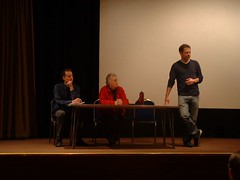
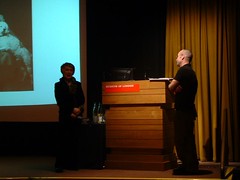
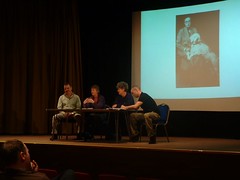
4- Peter Tatchell, Sue Sanders and Martin Dockrell. 5- Diana Souhami and Matt Cook. 6- Paul Barlow, Sue Donnelly, Linda Pointing and Matt Cook.
As I did last year, I then joined the London Gay Men's Chorus for a quick warm up and rehearsal before a short performance in the main foyer of the Museum. This was following a fashion show by members of the Kurdish community. There were about 150 people in our audience, representative of the ethnic richness and diversity of this great city that is London.
Further reading:
* Gay History of Britain: Love and Sex Between Men Since the Middle Ages, Matt Cook (lead author and editor), Robert Mills, Randolph Trumbach, H. G. Cocks, Greenwood Publishing, 2007 (not yet published)
* Troubled Vision: Gender, Sexuality, and Sight in Medieval Text and Image, Robert Mills, co-edited with Emma Campbell, Palgrave Macmillan, 2004
* Christianity, Social Tolerance, and Homosexuality: Gay People in Western Europe from the Beginning of the Christian Era to the Fourteenth Century, John Boswell, University of Chicago Press, 1980
* Forbidden Friendships: Homosexuality and Male Culture in Renaissance Florence, Michael Rocke, Oxford University Press, 1996
* Wild Girls: Paris, Sappho, and Art: The Lives and Loves of Natalie Barney and Romaine Brooks, Diana Souhami, Weidenfeld & Nicolson, 2004
* Gertrude and Alice: Gertrude Stein and Alice B.Toklas, Diana Souhami, Weidenfeld & Nicholson history, 2000
* The Trials of Radclyffe Hall, Diana Souhami, Virago, 1999
* Mrs. Keppel and Her Daughter, Diana Souhami, Flamingo, 1997
Tags: gay, history, LGBT, GLTB, lesbian, London, heritage, LGBT History Month , Museum of London, London Gay Men’s Chorus, bisexual, transgender, LGBT History Month, homophobia, gay rights.
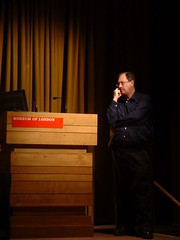
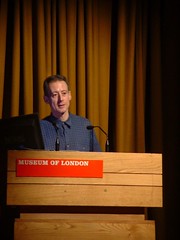
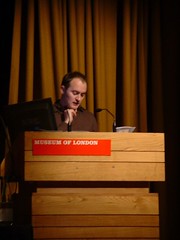
Comments
Post a Comment
Please leave your comment here. Note that comments are moderated and only those in French or in English will be published. Thank you for taking the time to read this blog and to leave a thought.